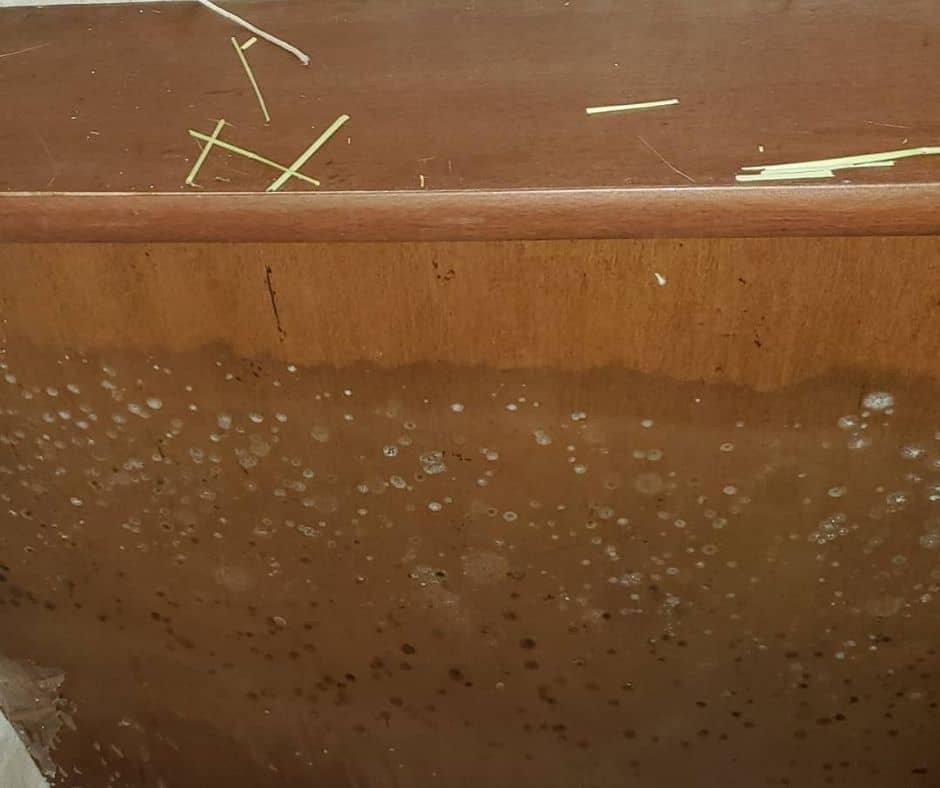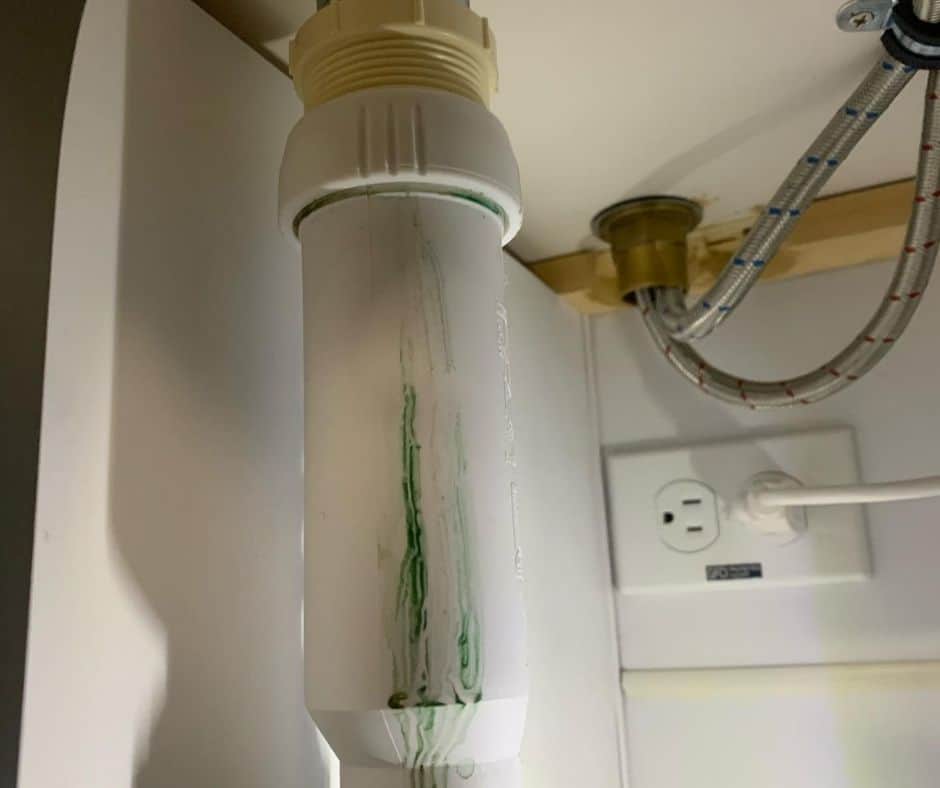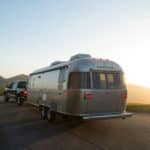Few things can put a damper on your RV vacation like battling mold and mildew while trying to answer the call of the open road.
Not only is mold in an RV ugly and malodorous, it can actually pose a serious threat to your family’s health.
This could come in the form of allergic reactions, sneezing, coughing, trouble breathing and more.
Dampness is the primary culprit that helps mold get a foothold in your RV especially during storage. Once a colony infests your RV’s interior it can be difficult to safely remove.
So, it’s best to take a proactive approach to protecting your RV from mold and mildew in the first place.
What Causes Mold To Grow Inside Your Camper?

Mold is a member of the fungi family. This means it spreads mold spores through the air all throughout the natural world.
This includes the forests you camp in as well as the air in your own backyard.
When one of these microscopic airborne mold spores lands in a wet, warm environment, it has the ability to germinate into an active colony. Some strains of mold can do this in as little as 48 hours!
With prolonged moisture and warmth, that colony can continue to grow. Eventually, it starts to excrete mycotoxins and other mold spores into the surrounding air.
This can cause respiratory irritation, as well as other medical conditions.
Individuals with compromised immune systems, a history of respiratory conditions like asthma and allergies as well as people with chronic inflammation conditions are increasingly likely to have strong reactions to a mold-contaminated environment.
What Places In An RV Are Prone To Mold Problems?
Since mold needs moisture to survive, you are most likely to find it in places where there is a lot of moisture and humidity.
This makes the bathroom, kitchen, and possible laundry room prime areas for mold growth.
Especially if you have a bad habit of not using the ventilation fan or hood vents when showering or cooking.
Though just like in a home, an RV with a water leak in the roof, or sidewalls can also create an environment for mold to thrive in.
This is especially true in RVs with leaky slide-out sections and popup campers with cracks in the canvas.
Signs There’s Mold in Your House RV

There are some obvious and some not-so-obvious signs of a potential mold problem in an RV.
If you’ve noticed one or more of the following things, chances are good that you have some type of mold problem.
How To Search For Hidden Mold In Your RV
Mold doesn’t always show itself in a highly visible place. Especially in an RV that has a current or past water leak in the roof, or if the mold has established a colony in the RV’s ventilation system.
While there are professional mold remediation services that can find these hidden mold colonies, they come at a higher price than a do-it-yourself-kit.
1: Mold Inspection Network DIY Mold Testing Kit
2. Monks Formula Air Mold Test Self-Analysis kit
3: ImmunoLytics 860004672807 DIY Mold Test Kit
How To Prevent Mold Growth In Our RV

Once it establishes a presence in your RV mold and mildew can be very challenging to deal with.
Being proactive about preventing mold in your RV requires a multi-phase strategy for when you are living in your RV as well as taking care of it when it’s in long-term storage.
The first step to preventing mold and mildew inside your camper is to stop or minimize the condensation and humidity.
Luckily, there are plenty of precautions you can take to make sure your camper in mold-free during the storage.
Use Ventilation
Humidity and condensation leave behind the moisture that mold spores need to germinate and grow.
Make sure to always use the vents fans in the bathroom when showering, as well as using the hood fan in the kitchen when you are cooking.
Clean & Dry Washing Machine
If your RV has a washing machine, make sure it is thoroughly dry after every use.
If you do happen to notice musty odors or other signs of mold you should use the washing machine’s self-cleaning mode, or follow the cleaning instructions in the owner’s manual.
Dry Clothes Outside Or In A Dryer
If you hand wash clothes or your RV doesn’t have a dryer, always make sure to dry your laundry and hand towels outside.
Not only will they dry faster, but they will prevent mold spores from potentially colonizing your laundry in your RVs living area, where they can later spread.
Use Dehumidifiers & Desiccants
When you are traveling consider plugging in a low-power mini dehumidifier this will capture ambient humidity and reduce the moisture levels that mold spores need to germinate and develop into an active colony.
When you aren’t using your RV, or if you don’t want to use power from the house batteries for a dehumidifier, you can use desiccants.
This could be painter’s desiccant or you might be able to find hanger desiccant bags in the closet section of a box hardware store.
Just keep in mind that all desiccants have a limited lifespan and need to be replaced every two to four weeks depending on the local humidity levels.
Update, Upgrade Or Maintain Your Air Conditioner
Air conditioners help to pull humidity out of the air, which can limit the moisture levels that mold spores need to colonize.
If your RV’s rooftop air conditioner is out of date, overtaxed, or poorly maintained it can fail to remove a sufficient amount of humidity.
At the same time, an over-taxed air conditioner is also prone to condensation issues. This can concentrate water leading to a mold problem near your air conditioner or in the vents.
Getting your RV’s rooftop air conditioner tuned up, or upgrading to a model with a higher BTU rating will help prevent these problems.
It will also help keep your RV’s interior nice and cool while limiting moisture in the primary living areas.
Clean Carpets & Wipe Surfaces
Ambient humidity that settled on carpets or builds upon porous materials like woodwork and trim can let trace amounts of mold develop when your RV isn’t in use.
Wiping down surfaces with a disinfectant wipe and vacuuming carpeting with a HEPA filter vacuum cleaner before you leave on a trip will help prevent disturbing mold spores from getting airborne while you travel.
Repair Water Leaks
Water leaks are all too common in the roof and ceilings of older RVs. Even a tiny leak in a corner can let a large volume of water into your attic and other areas that you can’t easily see.
This creates a prime breeding ground for mold, that can then spread out to infest the interior of your RV.
Address All Plumbing Problems Promptly
Even a minor leak from a drain gooseneck can produce enough water for mold to colonize.
Especially if the plumbing leak soaked some wood. You should also be suspicious of past water leaks from things like a cracked waterline as they can soak the wood deeply.
Then when temperatures warm up that damp woodwork can turn into a prime breeding ground for mold spores.
How To Remove Mold From RV Walls And Ceilings

Once mold gets into an RV, it can be hard to truly get all traces of it out.
With a significant mold problem, there is a chance that attempting to clean it up yourself can disturb the colony, causing it to release more spores into the air.
Then you end up with a new mold problem somewhere else. So, the goal is to catch mold, remove it, and clean the area as soon as humanly possible.
Bleach is a knee-jerk reaction cleaning solution that a lot of inexperienced people turn to when trying to kill mold on their own.
Unfortunately, bleach tends to kill mold at the surface, and can even help remove mold stains on some surfaces.
However, bleach does not do a good job of killing the microscopic roots that mold makes in porous materials like exposed wood.
Ultimately, you want to use cleaning products that have oxygen as the active cleaning ingredient or other potent chemicals like sodium hypochlorite. So What products are best for removing mold from your camper?
Here are 3 great hydrogen peroxide-based mold treatment solutions to use instead of bleach.
- 1: RMR-86 Instant Mold and Mildew Stain Remover Spray
- 2: Wet & Forget 802128 Mold and Mildew Cleaner
- 3: DWD2 Protect B0875J27C9 Automotive Mold Treatment
Frequently Asked Questions
When Should I Contact A Professional Mold Remediation Service For My RV?
Most minor mold problems in an RV can be cleaned up and remediated on your own. Just make sure to wear a quality mask and gloves.
Sometimes badly mold-infested woodwork, wallpaper, and carpet need to be completely removed.
If you aren’t up for the task, or you are concerned that mold has spread to hard-to-reach places like the ventilation system or the insulation in the ceiling/attic, you might want to call in a professional mold remediation service.
They can assess the severity of the problem and present you with an effective mold remediation plan.
What Is The Difference Between Mold & Mildew?
Mildew tends to live on the surface of the materials it affects. It doesn’t release the same harmful mycotoxins and spores that an active mold colony tends to do.
This also means that mildew is far easier to clean and mildew stains tend to be much easier to remove with bleach-based cleaners.
Mold spreads microscopic roots deep down into porous materials like wood, which makes it hard to kill, and increases the risk of the mold returning again.
Can I Paint My Camper Over Mold?
It’s tempting to paint over mold in an “Out of Sight, Out of Mind” sort of way.
Unfortunately, paint does not kill mold. Instead, the colony continues to fester under the surface.
As it does it can cause significant damage to the underlying wood and other soft materials.
Eventually, it can start to bubble up or cause cracks in the paint returning a few months later with even more problematic consequences.
Conclusion
Mold can be a real problem in an RV. Not only can it damage the RV, and reduce your potential resale value, but it can even be a serious health hazard leading to significant health problems for you and your family.
It’s also worth noting that some states require a disclosure statement for a vehicle, like an RV when you sell it, which can be a legal liability concern.
Ultimately, it’s best to take a proactive approach to prevent mold in your RV. This starts with keeping it clean and properly maintained.
Bathroom vents and kitchen hood exhaust systems need to be used diligently.
Taking steps to manage interior humidity during the peak of summer will also go a long way toward keeping mold out of your RV.
This might call for using dehumidifiers and desiccants, as well as making sure that your RV’s rooftop air conditioner is operating properly.


![6 Must See RVs With a Roof Observation Deck In [currentyear] 6 RVs & Travel Trailers With a Roof Deck](https://www.rvingknowhow.com/wp-content/uploads/2022/03/RVs-Travel-Trailers-With-a-Roof-Deck-150x150.jpg)



